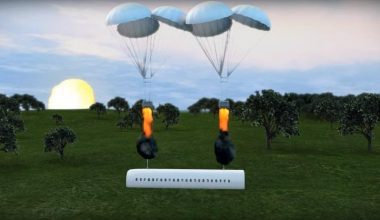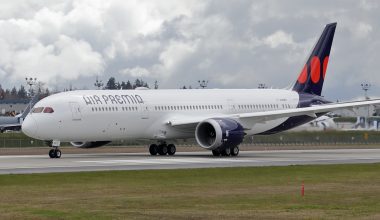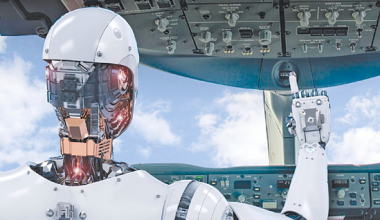
How Do Airplanes Navigate?
Navigation simply means to find out your current position, and direction then coordinating and monitoring it. So, proper navigation ensures that you are not off the track; it always makes sure that you are at known position with some reference. Navigation techniques have been practicing since the locomotive life started. The traditional navigation method for human was to look at the stars or Venus. The ship navigation still practices this because the position of star doesn’t change for long time. Not only humans, animals also have peculiar navigation techniques. Bats use ultrasonic sound to navigate. Elephants use cumulonimbus clouds to navigate in dry season. Wildebeests follow the scent of rain when the shower hits the dry Serengeti soils, to reach greener pastures. Hyenas watch the vultures and locate the carcass. So, navigation is very crucial for every organism.
Air navigation is not much different with the different techniques I just introduced you with. It is the art and technique to control and monitor the aircraft components and take the aircraft to the destination. Since airplanes don’t have their navigation instinct they need coordination of airborne equipment’s, pilots and ground station. Flight management system, FMS is a combination of various sensors and equipment to help your flight in the right flight track. FMS is not equipment, it is a system. It is the brain of the navigation system that coordinates various organs of navigation to work properly. However, air navigation varies from types of airplane, the airports they land and many other parameters. So, let’s see some of the common air navigation techniques.
Pilotage: Pilotage in air navigation means navigation using ground references or landmarks only. This is a very simple navigation technique which uses VFR (Visual Flight Rules) and is effective during a clear day. The pilot identifies various landmarks like terrains, mountains, ponds, rivers, highways, buildings, airports and keeps track of them. This is one of the oldest air navigation technique in which pilot uses visual references to guide them. Pilots are provided with aeronautical chart and they keep comparing the visuals with those of charts to find out if they are on the right track. The major limitation of this method is that it completely depends on ground visuals. So, when the sky is not clear, it doesn’t work. These are practiced by smaller aircraft which fly at low altitude and which are very less passenger carrier. Due to this reason most of the smaller aircraft in Nepal do not prefer to fly in bad weather.
Dead Reckoning: Dead reckoning is as simple as doing your elementary school physics to calculate distance from velocity and time. In this case you calculate your position in certain interval of time and mark your position at that instant. For the next interval that particular position will be your reference point. It is a simple mathematical calculation which helps to plot a course using course line elements, airspeed, course, heading and elapsed time.
Pilots use manual or electronic flight computer to calculate airspeed, elapsed time between two points, fuel consumption, density altitude and many other en route data and these are the parameters to find out the position. The direction is measured using gyro-compass. If you maintain the direction and if you know the time and airspeed you know your exact position. The fundamental characteristic and its prime disadvantage is that the accuracy of this method is time dependent. Due to its errors build errors DR method is just taken as a reference to concur the result with other navigation equipment. Inertial Navigation System, INS, is an advanced navigation system is also a type of DR navigation. It uses gyros and can work combined with Doppler’s effect to be a very advanced navigation system. INS is adopted in many airlines nowadays.
Position Fixing Navigation: When you’re cruising at the altitude above 30,000 feet, you don’t look at the rivers or buildings, do you? So, there is a position in the sky called “fix” which is the position reached by aircraft following a specific route. This “fix” can be obtained by recognizing a prominent landmark or set of terrain either visually or instrumentally.
Position fixing navigation system depends on external references to find out their position. They use radio navigation where information is provided to the airplane or pilot from ground stations located worldwide. When a new acquaintance wants to come to your house and he asks you how to reach there then you tell him on phone his current position with respect to house and the succeeding directions and points he must then head. You also tell him how much time he takes from there to reach you. Well, PF navigation is exactly same. There is someone outside to tell you where you are and how you should head. Unlike DR navigation system its errors are not time dependent. Almost all cross-country flight use radio navigation as their primary or secondary navigation aid.
The various radio navigation systems are:
1. Automatic Direction Finder (ADF): ADF are the oldest radio navigation system which uses non-directional beacons (NDBs). These ADF are still in use in many aircraft. The NDB is stationed on the ground and emits the electrical signal in low and medium frequency band from 190 to 535 KHz. All ADFs can also home in on AM broadcast stations. Pilot listens to the broadcasted radio wave and navigates accordingly. The aircraft with ADF will display the aircraft’s position in relation to NDB station on ground. The ADB instrument has a compass card type display where the arrow always points in the direction of NDB station. Since it operates in AM-radio frequency of low-medium frequency band they are more prone to errors and pilots are more likely to receive erroneous readings while flying in terrains or too far from ground station.
2.VOR: VOR stands for Very High Frequency Omni-directional Range. It is an electronic navigation system that uses all directional range station to provide the pilot with courses from any point within service range. It is a radio beacon on a ground that allows an aircraft to identify their location relative to the VOR itself. VOR emits two VHF radio waves one unchanging waves in all directions and second one is variable wave the phase which changes as it rotates. So, VOR receiver inside of the aircraft compares reference and that allows us to determine which radio from the station that the aircraft is up to. VOR radios are emanating from the station as a bicycle spoke coming from central hub in all direction. The difference is VOR does in 3600 radial.
Inside the aircraft, the airborne equipment includes the navigation radio, the VOR indicator and antenna. VOR indicator has a vertical needle called a CDI or course deviation indicator that shows whether the aircraft is at left or right of the chosen course. There is omni-bearing selector, OBS which is turned until CDI reads “to/from”, to indication when aircraft has to fly towards the station. After this the pilot continues in that heading. “From” indication is located from the station and when the aircraft is on centerline to the station “off” indication is given. The only thing that matters is the tuning of aircraft VOR equipment with correct radial one. Once it is done you will always find the correct airport.
3.Distance Measuring Equipment (DME): DME is used by all aircrafts nowadays. DME is a form of radar, an electronic device that allows an aircraft to automatically measure distance information like height at which aircraft flying, its angle from ground station and its unknown ground range perpendicularly measured. The accuracy of the DME is 2 miles flying at an altitude of 10,500 feet AGL and at this position on the aircraft could directly be over DME station. DME can be combined with VOR and NDB also.
DME works on the principle of difference in time pulses between interrogation and replies. The airborne equipment called interrogator transmits pulses of 1 KW peak power on 1 to 126 frequencies of VHF band and each pulses delayed by with certain microsecond. The target located on the ground is called “transporder” or “ground beacon”. The transpoder receives pulses delays them by 50 microseconds; purpose of the delay is to eliminate the possibility of uncoordinated operation when aircraft is very close to ground station, and then transmits them at 1 KW on 252 frequencies. The difference in frequency between information from transporder and interrogator is always 63 MHz. The interrogator receives reply and measures the elapsed time of interrogation and reply. It subtracts 50 microseconds delay and use simple arithmetic to find out that it takes 12.359 microseconds for a signal to go and return one NM. It then displays the computed distance on DME readout.
4.Instrumental Landing System (ILS): ILS is a ground based instrument approach which provides precision guidance to an aircraft while approaching and landing on the runway. ILS are very often used in safe landings when there is fog, mists, heavy snow, low ceiling, heavy rain and when pilot can’t exactly see the ground references. The ground system comprises of two highly directional transmitting system called localizer and guide slope and three marker beacons. Localizer is an antenna ray which has directional antenna to transmit its two signals, each transmit narrow beam one slightly left of the runway centerline and the other slightly to the right. It gives information to indicate whether aircraft is on left or right of runway centerline. A glide slope is an antenna ray at one side of runway touchdown zone approximately 150m away. It provides vertical guidance or elevation and indicates whether aircraft is above or below the glide path for the approach. This ensures aircraft is flying above glide path and remain above obstructions and reach the runway at proper touchdown point. The pilot should control aircraft such that localizer and glide slope indicator remain centered in the display. To ensure proper landing marker beacons are used for identifying their location on approach with the help of outer beacon, middle beacon and inner beacon located at respective distances from runway threshold.
5.Global Positioning System (GPS): GPS network is made up of multi-satellites at an altitude of 17,500 km. This system is tremendously precise and reliable. The GPS system works on triangulation technique to determine the aircraft exact position over the earth. The GPS system gathers data from at least three satellites for 2D positioning and at least four satellites for 3D positioning. The data from all three (or four) satellites should concur to display the final result. The GPS uses atomic clock which has time accuracy of 1 part per billion i.e. accuracy of GPS clock is 0.003 seconds per thousand years and the clock keeps updating itself with its users every time. The GPS satellite shares it position information with its users so the relative position the user is known to the GPS satellite. Then it calculates it latitude, longitude and altitude. GPS can provide all necessary navigation information like bearing, ground speed, track, range, ETE, cross track error, desired track, winds and drift angle etc.
Despite being so many navigation techniques aircraft are equipped with more than one navigation system. Sometimes the system works better in a combo and sometimes individually. Generally GPS and ILS are more preferable and advanced but there are limitations of aircraft and airports not to be compatible with these techniques.
Author: Bikram Koirala
Mechanical Engineering
Central Campus, Pulchowk
References:
1.nationalgeographic.org/activity/animal-navigation
2.aerosavvy.com/pilots-navigate/
3.virtualskies.arc.nasa.gov/navigation/2.html
4.aviation.about.com/od/Navigation-Advances/a/Air-navigation.html
5.indianapublicmedia.org/amomentofscience/airplane-navigation/
6.http://www.quora.com/How-do-pilots-find-their-way-in-the-empty-sky
7.http://en.wikipedia.org/wiki/Air_navigation
8.http://www.airliners.net/forum/viewtopic.php?t=766623
9.https://www.pea.com/blog/posts/pilots-navigate/






